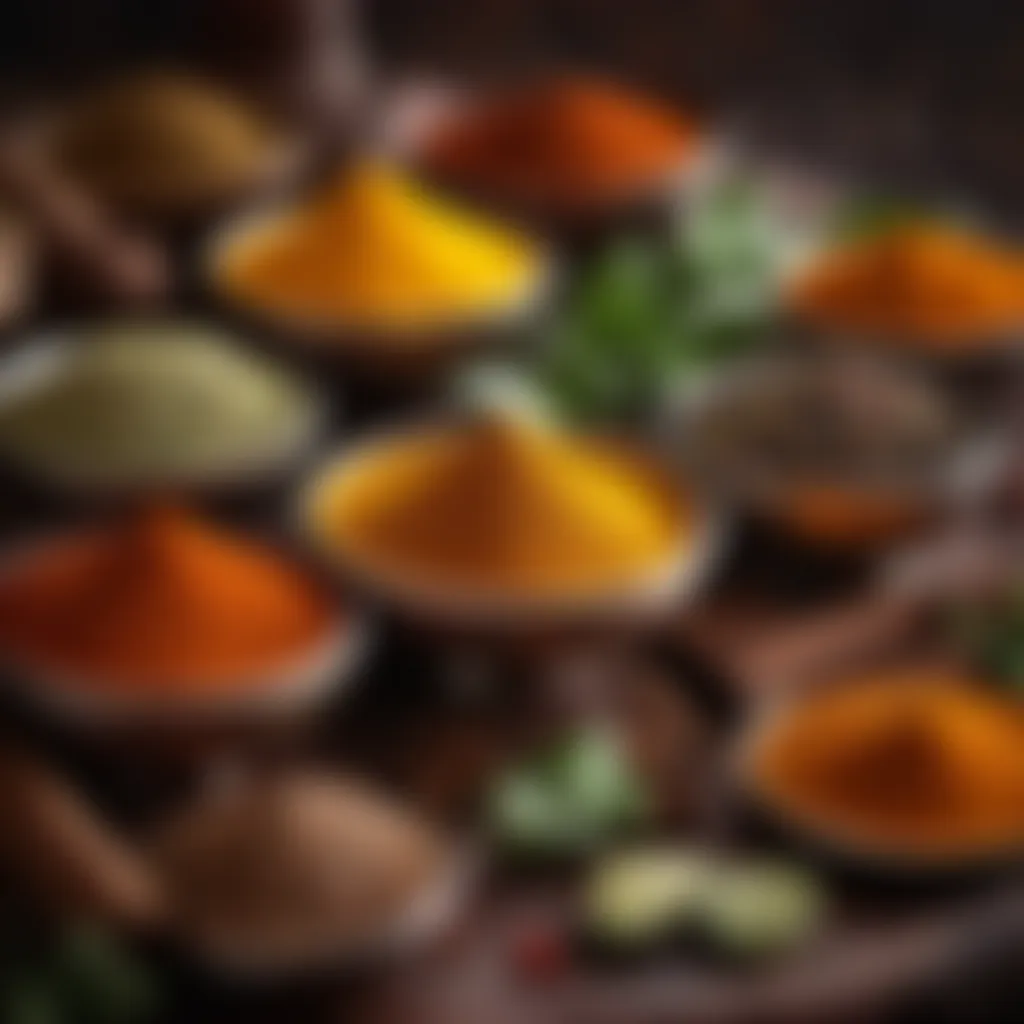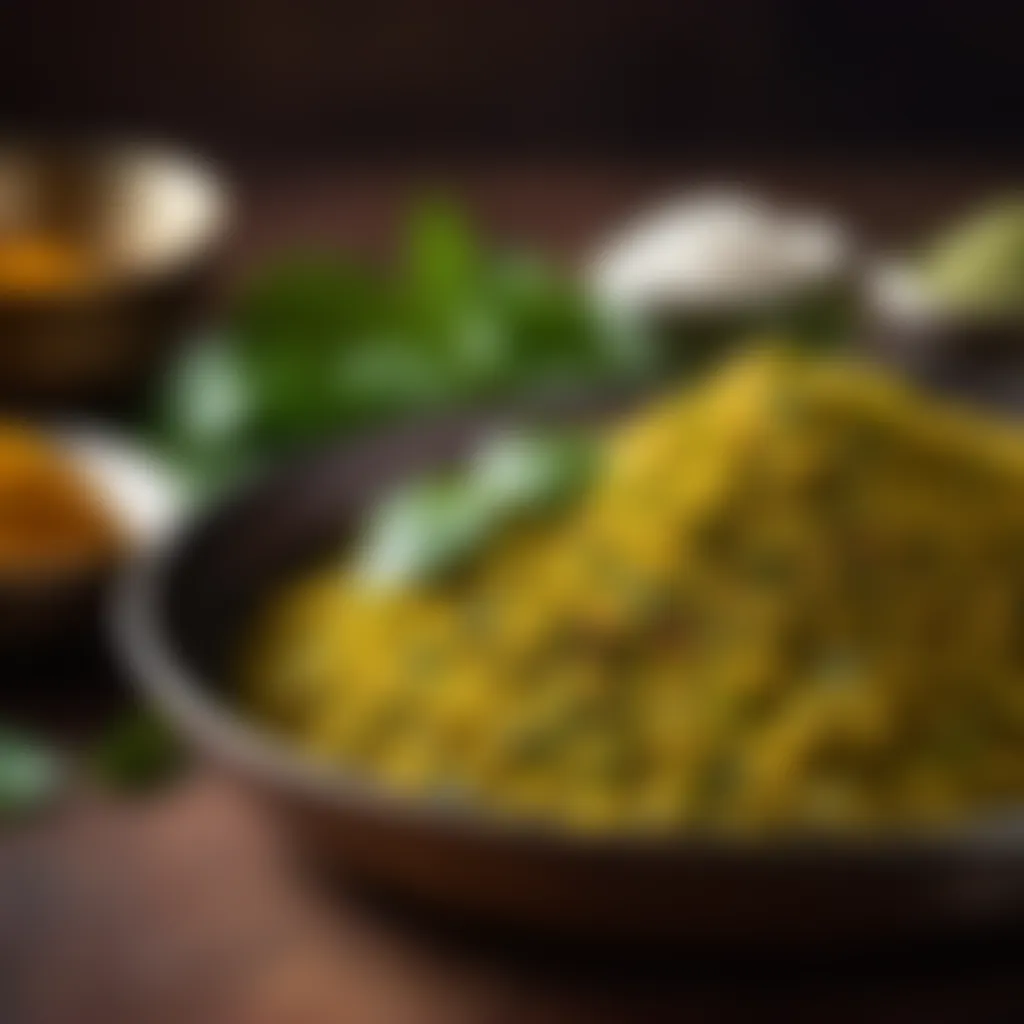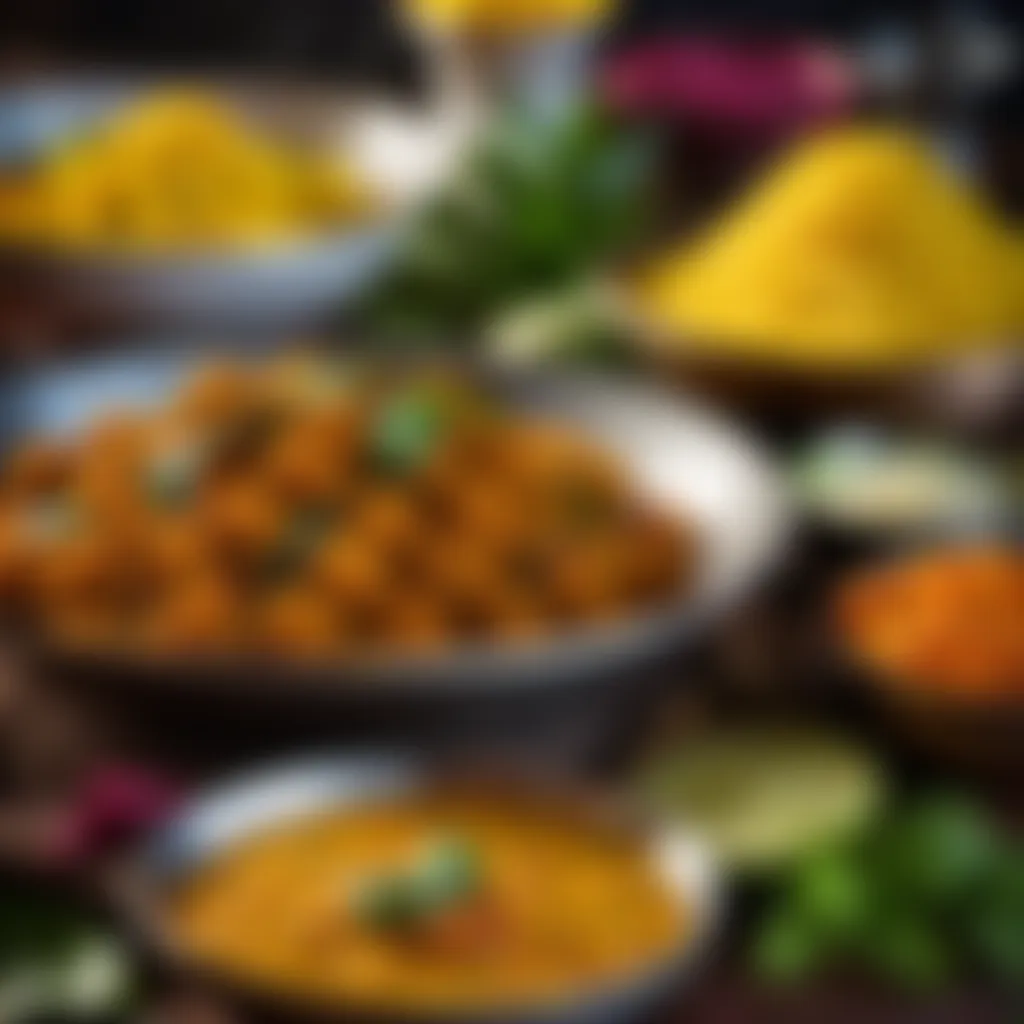Mastering Tamil Cuisine: Essential Cooking Insights


Intro
Stepping into the kitchen to prepare Tamil cuisine is like embarking on a journey steeped in tradition. The air is filled with a medley of spices, each telling its own story, representing the heart of vibrant South Indian culture. As a housewife delving into this culinary realm, it’s vital to understand not just the ingredients, but also the techniques that turn these simple elements into a tapestry of flavors.
Cooking Tamil food is a cherished ritual, where each dish is a homage to the rich heritage of Tamil Nadu. With a cuisine rooted in both simplicity and complexity, the skills you acquire can transcend generations. Whether you’re armed with some experience or just a sprightly beginner, your enthusiasm in the kitchen can transform everyday ingredients into memorable meals.
Through this exploration, we will dive deep into the essential aspects of Tamil cooking—beginning with identifying the ingredients crucial to crafting authentic dishes. It’s where the journey begins and the heart of Tamil cooking unfolds.
Prelude to Tamil Cuisine
Tamil cuisine is not just about food; it’s an elaborate dance of flavors, colors, and aromas that has been perfected over centuries. It bears testament to the rich history and traditions of the Tamil people. When one embarks on the journey of mastering Tamil cooking, the first thing to grasp is its foundational significance—it's a mirror reflecting both the historical narratives and cultural ethos of the Tamil community.
One cannot overlook how Tamil cuisine marries simplicity with depth. Every dish tells a story; each ingredient has a purpose, harmonizing to create a culinary experience that transcends mere sustenance. Recognizing that it's an art form as much as it is a science is essential. This isn’t just about throwing together spices and rice; it's an intricate process that intertwines love, patience, and skill, gravitating towards the goal of a sumptuous meal.
Additionally, understanding the historical context and cultural significance behind Tamil dishes provides insights that can elevate one's cooking. With a focus on local produce and regional diversity, Tamil cuisine varies wildly from one area to another—what's standard in Chennai might be a rarity in Madurai.
Thus, the introduction to Tamil cuisine sets the stage for a full appreciation of the core ingredients, cooking techniques, and regional variations that one will learn to navigate in this article.
Historical Context
Tamil culinary practices have deep roots in ancient history, likely dating back over two thousand years. The earliest references to Tamil food can be found in Sangam literature, where poets extolled the virtues of local agricultural practices and the richness of the land. The proximity to the sea further contributed to the incorporation of seafood into meals, especially along the coastal regions.
The exchange of ideas through traders, invaders, and settlers over time led to the influence of various cultures on Tamil cooking. For instance, the British colonial period introduced new ingredients and cooking techniques, which were embraced and adapted in unique ways by Tamil cooks. The spices trade, coupled with the agricultural advancements, has made Tamil cuisine both rich and diverse.
This historical evolution underscores the necessity of understanding the past when setting out to learn Tamil cooking. It offers valuable context—how dishes came into being and where the nuances stem from.
Cultural Significance
When diving into Tamil cuisine, one must consider its profound cultural significance. Food in Tamil Nadu goes beyond the act of eating; it’s a central feature of festivals, family gatherings, and everyday life. Rituals often involve traditional recipes passed down through generations, with each dish embodying a family’s legacy and memories.
It's also important to note that Tamil cooking is inherently tied to the agricultural calendar. Every festival marks its own unique set of dishes reflective of seasonal produce. For example, Pongal, a harvest festival, sees the preparation of 'Pongal,' a rice dish cooked with jaggery and lentils, showcasing the bounty of the season.
"Cooking in Tamil culture isn’t just an act; it’s a celebration of life and an act of devotion."
In essence, Tamil cuisine embodies the spirit of community, connection, and continuity, making it vital for anyone looking to fully appreciate and master this culinary art.
Through understanding the historical context and the cultural values that shape this cuisine, one sets a strong foundation for not just learning how to cook but also appreciating the deeper meanings behind the dishes.
Core Ingredients in Tamil Cooking
Understanding the core ingredients of Tamil cooking is much like knowing the soul of a melody - it sets the tone for every dish you create. In this exquisite cuisine, ingredients are not mere components, but pivotal players that weave their flavors into a tapestry of tastes and aromas. From spices to grains, every element is steeped in historical significance and contributes to balancing the diverse palette that Tamil dishes are known for.
Spices that Define Flavors
Spices are the heartbeat of Tamil cooking. They are what transform a simple dish into an extraordinary experience. Common spices include:
- Turmeric: This golden spice doesn't just add color but is also known for its health benefits. It has an earthy flavor that enhances the depth of a dish.
- Cumin: Whether in seed or powder form, cumin brings a warm, nutty taste that works well with lentils and vegetables alike.
- Mustard Seeds: When tempered, these tiny seeds burst with flavor, giving an addictive crunch to the dishes.
- Coriander: Ground coriander seeds provide a citrusy undertone that lightens the heavier flavors present in many Tamil curries.
A key technique when using these spices is tempering. This process involves heating oil and adding spices to it, allowing their essential oils to release and infuse the oil with flavor before mixing it into the main dish. It’s essential to master this technique, as the flavors become more pronounced and complex.
"Cooking is like love; it should be entered into with abandon or not at all."
Vegetables and Their Importance


Vegetables in Tamil cuisine are not just side dishes; they are the stars that share the stage with spices. Seasonal and fresh, they account for the variety in texture and flavor.
Common vegetables include:
- Brinjal (Eggplant): A staple in many dishes, brinjal absorbs spices well, making it a flavorful addition to curries like Kathrikai Masala.
- Drumsticks: Besides their unique taste, they also add a fibrous texture to sambar and other stews, making them nourishing and filling.
- Green Leafy Vegetables: Varieties such as spinach and amaranth are not only nutritious but also add vibrant colors and flavors to the meal.
In Tamil cooking, it’s important to respect the vegetables. This means choosing the freshest produce and using them in a way that showcases their unique characteristics. Stir-frying, steaming, or using minimal oil helps retain their nutritional value and taste.
The Role of Grains and Lentils
Grains and lentils are the foundation of Tamil meals, providing a necessary balance of protein and carbohydrates. The most common are:
- Rice: Steamed rice is often the base of most Tamil meals, serving as a canvas for various curries and side dishes.
- Toor Dal: Known for its high protein content, toor dal is essential for crafting dishes like sambar or dal fry. It has a pleasant, nutty flavor that complements spices beautifully.
- Black Gram (Urad Dal): This lentil is used in both savory dishes and batters, like that for idli and dosa, providing texture and richness.
These grains and lentils can be utilized in a variety of ways, from simple boiled preparations to elaborate, spiced dishes. Incorporating them into your meals enhances not just the dish’s nutritional profile but also its overall heartiness.
In summary, the core ingredients in Tamil cooking each bring their own story and flavor to the table. Mastering them is essential for anyone wishing to venture into Tamil cuisine and offers a gateway to creating authentic dishes that resonate with tradition and flavor.
Essential Cooking Techniques
Understanding the essential cooking techniques in Tamil cuisine is crucial for anyone looking to master this rich and vibrant culinary tradition. Each technique serves a purpose, enhancing flavors, textures, and overall presentation of the dishes. Mastering these methods not only elevates the cooking process but also contributes to the depth of flavor that characterizes Tamil food. Whether you are a seasoned cook or a novice, grasping these techniques can transform your culinary experiences.
Tempering and Seasoning
Tempering, or tadka, is a foundational technique in Tamil cooking. It involves heating oil and adding whole spices, like mustard seeds, cumin seeds, or dried red chilies, which create a bold aroma that sets the stage for the dish to come. This process releases essential oils from the spices, infusing the oil with flavors that then penetrate the ingredients added later.
The procedure for tempering is quite simple, but there are some nuances. Start with a pan on medium heat and add the oil. Once the oil is hot, toss in the spices and observe their reaction. When the mustard seeds begin to pop or the cumin seeds turn a darker shade, it’s your cue to add your onions or any other ingredients. This interplay between heat and spice can make all the difference in taste and aroma.
- Tip: Always use freshly sourced spices to achieve the best flavor. Stale spices won’t bring out the bright notes that tempering is known for, leading to a sluggish taste.
"A good tempering can transform a simple dish into something extraordinary."
Cooking with Aroma and Flavor
Cooking in Tamil cuisine goes beyond just the ingredients; it’s about crafting a symphony of aromas that engage the senses. Layering flavors is an essential aspect. Think of it as building a melody with spices, where each note has its place in the song.
To achieve that, one must consider the timing of adding various ingredients. For example, garlic and ginger should not be added too early in the cooking process, as their flavors can become too harsh. Instead, they are best introduced after the onions are an attractive golden brown, allowing them to meld seamlessly into the mix.
Fresh herbs like curry leaves and cilantro can also brighten up dishes, providing both flavor and a visual aesthetic that is hard to resist.
- Benefits of Cooking with Aroma:
- Enhances appetite and enjoyment of food.
- Creates a sensory dining experience.
The Art of Steaming and Boiling
Steaming and boiling are techniques often overshadowed by more flamboyant cooking methods, but in Tamil cuisine, they hold paramount importance. They preserve the natural nutrients present in the ingredients, making your dishes not just tasty but also healthy.
Idli, the iconic steamed rice cake, is a prime example. Using a traditional steamer ensures that steam penetrates each cake uniformly, resulting in a fluffy texture that melts in your mouth. For this technique, using the right batter consistency is essential, as too thick or too thin can ruin the final product.
Similarly, boiling can be effectively used to create dishes like sambhar, where lentils and vegetables cook down to a creamy consistency. The key is to manage the heat to avoid overcooking.
- Key Points for Efficient Steaming and Boiling:


- Use a steamer for even distribution of heat.
- Ensure the boiling water is at a rolling boil before adding ingredients.
- Experiment with timing to gauge the tenderness of your vegetables.
Mastering these essential cooking techniques is a vital step towards creating authentic Tamil dishes that delight both the palate and the eyes. As you practice these methods, remember that cooking is not just about following instructions; it's about fostering an understanding of how flavors interact, and how the subtleties of technique can lead to culinary triumph.
Regional Variations in Tamil Cuisine
When it comes to Tamil cuisine, one of its most distinctive features is its rich tapestry of regional variations. Each area brings its own unique twist to traditional dishes, allowing for an array of flavors and textures that keep the culinary landscape vibrant. Understanding these regional differences not only enhances one’s cooking skills but also underlines the diversity and cultural heritage that Tamil cooking embodies.
Coastal Influences on Dishes
The coastal regions of Tamil Nadu, particularly areas like Chennai and Kanyakumari, significantly influence Tamil cuisine with an abundance of seafood. Fish, shrimp, and crabs are staples, often cooked with local spices and coconut. For instance, the preparation of Meen Kulambu (fish curry) showcases how fresh catch is prepared with tamarind, allowing for a delightful tanginess that pairs beautifully with rice.
To highlight this,
- Local spices: Mustard seeds, curry leaves, and coconut milk create an aromatic experience.
- Cooking Techniques: Steaming and grilling are common, preserving the fresh taste of the seafood.
This region's cooking reflects the relationship between the land and sea, where meals often celebrate the bounty of the ocean.
The Spicy Land of Chettinad
Deep in the heart of Tamil Nadu lies the famous Chettinad region, renowned for its fiery flavors and aromatic spices. The cuisine here is rich and varied, often featuring robust dishes that make liberal use of spices such as star anise, fennel, and black pepper. Chettinad chicken curry is a prime example; it’s not just spicy, but a fiesta of flavors achieved through the toasting and grinding of spices, allowing their oils to release into the dish.
In Chettinad,
- Spices are central: The emphasis on heat and warmth alters perceptions of flavor.
- Complex preparations: Dishes may require longer cooking times but are worth the effort for their depth.
The bold flavors of Chettinad cooking offer a transforming experience, encouraging even the novice of cooks to try their hand at spice combinations.
The Subtle Flavors of Kongu Nadu
Contrasting sharply with the spiciness of Chettinad, Kongu Nadu, situated in the western foothills, offers a more wholesome and subtle approach to flavor. Ingredients are often locally sourced, and there is a notable use of millets and jaggery. The emphasis is on balanced flavors that highlight the natural sweetness of these ingredients.
Dishes like Kongu-style sambar use lesser-known vegetables and spices that provide an earthy taste, considered comforting and nourishing.
- Local staples: Ragi (finger millet) and other grains feature prominently.
- Cooking philosophy: Meals are often vegetarian, emphasizing simplicity and health.
The essence of Kongu Nadu cuisine is its connection to nature, making it a refreshing take for those looking to explore off the beaten culinary path.
"Regional variations in Tamil cuisine reflect the landscape, traditions, and lifestyles of the people, with each dish telling a story of its origin."
To sum up, the regional variations in Tamil cuisine highlight the rich diversity within this culinary tradition. From the coastal flavors that sing of the ocean to the spicy exuberance of Chettinad and the subtle elegance of Kongu Nadu, there's a world of flavors waiting to be explored. Each region has its charm and style, making Tamil cuisine an endless journey of taste, tradition, and tales.
Popular Tamil Dishes to Master
Mastering Tamil cuisine wouldn’t be complete without diving into the popular dishes that define its rich culinary landscape. These staples not only represent the flavors and techniques of Tamil cooking but also reflect the historical and cultural narratives of the region. Each dish tells a story, presenting opportunities for cooks of all levels to connect with Tamil heritage.
When you embrace these recipes, you are not just cooking; you're participating in a tradition that's been passed down through generations. Mastering these dishes can elevate your culinary skills and bring a touch of Tamil culture to your table.
Sambhar: A Staple of Tamil Meals
Sambhar is more than just a lentil-based stew; it’s a fundamental element of Tamil meals. A steaming bowl of sambhar can bring warmth to any dining experience. It’s crafted from a blend of lentils, tamarind, spices, and an assortment of vegetables, making it nutritious and satisfying.
To prepare sambhar, the key is in the sambhar powder, a unique mix of roasted spices which typically includes coriander, cumin, and dried red chili. Each household often has its own variation of sambhar, adding a personal touch with local vegetables. This dish can be paired with rice or served alongside idli or dosai, showcasing its versatility.


Rasam: The Comfort Soup
Closely linked with the everyday lives of Tamil people, rasam is often referred to as comfort in a bowl. It's a tangy soup made primarily from tamarind juice, tomatoes, and a special spice mix. The simplicity of its ingredients doesn’t compromise the depth of flavor; rather, it highlights every component, creating an inviting aroma as it simmers.
Rasam serves many purposes: it can function as a stand-alone soup, a flavorful base for rice, or even a palate cleanser between heavier dishes. The beauty of rasam lies in its adaptability—each cook has the freedom to modify it to their taste, whether to make it spicier or add unique herbs like curry leaves.
Dosai: The Iconic Crepe
When talking about Tamil breakfast, dosai inevitably takes center stage. This thin, crispy crepe is made from a fermented batter of rice and urad dal, which gives it a light texture and a distinct sour flavor. The batter's fermentation is crucial—it not only enhances the taste but also aids in digestion.
Dosai can be enjoyed in numerous forms—from the classic plain version to stuffed varieties filled with spiced potatoes. Many families serve dosai with a side of chutney and sambhar, creating a perfect harmony of flavors. The art of flipping a dosai is also something that can take years to master, resulting in a delicious resolution for those who persevere.
Idli: Steamed Perfection
Idli, the beloved steamed rice cakes, represents a staple that is both healthy and filling. Made from the same fermented batter as dosai, idli holds its own unique charm—a fluffy texture coupled with a tender crumb. Traditionally served with chutney and sambhar, these cakes can be a versatile part of any meal.
One of the intriguing aspects of idli is its steaming method, which retains moisture and ensures that they're light. Cooking idli might initially appear simplistic, but achieving the right batter consistency and the perfect steam time can be a delicate balance.
As families come together to enjoy these beloved dishes, it’s clear that they are more than just food—they're a vessel for connection and a bridge to Tamil culture. Each dish has its own personality, reflecting the diversity and richness of the region’s culinary heritage. By mastering these staples, you open up a world filled with flavor and tradition.
Presentation Techniques
In the world of Tamil cuisine, how a dish looks is almost as vital as how it tastes. Presentation techniques elevate a meal from merely edible to a feast for the eyes. A well-arranged plate can whet the appetite and create an inviting atmosphere at the dining table. Not only does good presentation reflect the care taken in cooking, but it also embodies the cultural significance behind Tamil cuisine. This section explores some essential aspects of presenting Tamil dishes and the profound impact it has on the overall dining experience.
Arranging the Plate
When it comes to arranging the plate, balance plays a crucial role. Think of each dish as an artwork; every element needs a place where it can shine. Start by considering the size of your plate. A larger plate can help make smaller portions feel more spacious, whereas a smaller plate can beautifully contain rich, vibrant meals. For instance, when serving sambhar, placing it in a small bowl at the center of the plate can create a focal point. Around it, arrange the other elements, like idlis or dosas, so that they complement the sambhar visually.
Furthermore, height can also add an appealing dimension. Stacking idlis or laying dosas in a slight arc can invite curiosity and engagement. Finally, leave some empty space on the plate. Nestling a few curry leaves or a slice of lemon can serve as a fresh pop of color, enhancing visual appeal while expressing the freshness inherent in Tamil cooking.
Color and Texture Combinations
Using color and texture in presentation is where creativity flourishes. Tamil cuisine is inherently colorful—think of the bright orange of sambhar, the green of coriander chutney, and the golden brown of dosas. It’s essential to utilize these vibrant colors for visual contrast.
- Experience Texture: Incorporate varied textures to elevate the eating experience. A crispy dosa alongside soft idlis introduces a delightful textural contrast. On the other hand, consider adding a sprinkle of roasted peanuts or fried onions to sambhar; this not only adds crunch but also visual intrigue.
- Harmonizing Colors: When arranging, try to group colors somewhat strategically. For example, light-colored items like idlis can be paired with darker elements like sambar. Adding a dash of green, whether through garnished herbs or a dollop of green chutney, can give that extra flair.
- As a Rule of Thumb: Avoid the pitfall of overcrowding the plate; this only tends to confuse the eye and detract from the beautiful aspects of each dish.
"Presentation is more than mere aesthetics; it’s an invitation to explore the flavors within each dish."
Creating an engaging plate is not just about artistry; it’s about storytelling. Every meal serves as a bridge linking tradition and innovation, simplifying even the most complex of flavors into a visual poem. With these tips in mind, embracing the art of presentation will lead to a richer culinary experience, whether for a family meal or a special gathering.
Ending and Reflection
The exploration of Tamil cuisine is not just a journey through flavors and ingredients. It’s an adventure that unearths a vast cultural heritage, deeply rooted in both tradition and family gatherings. As we wrap up the essentials of mastering this culinary craft, it's crucial to reflect on what the process entails and the importance of every step.
The Journey of Tamil Cooking
When you embark on this culinary journey, you start with the ingredients. Each spice, herb, and grain tells a story, indicating its place of origin and its significance in Tamil cooking. For example, the aroma of cumin seeds sizzling in hot oil sets the stage for a dish that is both comforting and familiar. You'll find that like anything worthwhile, Tamil cooking requires patience and dedication, from understanding the balance of spices to mastering the cooking techniques that enliven those flavors.
Moreover, Tamil cuisine encourages a connection to one’s roots. Many families pass down recipes that may have been enjoyed for generations, often accompanied by stories of family members who prepared them. This not only enriches the dining experience but also serves as a reminder of where you came from and who you share your meals with. These traditions form the backbone of Tamil culinary practices, creating a sense of belonging and community.
Encouragement to Explore Further
As you stand at the end of this article, remember that this is merely the beginning of your exploration into Tamil cuisine. The world of Tamil cooking is as wide as the ocean. Consider diving deeper into regional variations and unique dishes that you haven't yet encountered. The rich seafood dishes of coastal Tamil Nadu and the robust flavors from Chettinad region are waiting to be discovered.
Seek out local markets to find fresh, authentic ingredients that will enhance your repertoire. Experimenting with different recipes will lead to delightful surprises and maybe even some happy accidents in the kitchen.
"Cooking is love made visible."
In this light, the art of cooking is not just a task; it's an expression of creativity and passion. Embrace these cooking adventures with an open heart and a willingness to explore, and soon you'll not only become proficient but might also develop your own favorite twists on traditional dishes.
Remember, every plate tells a story. Each meal becomes a new chapter, adding to your narrative in the world of Tamil cuisine. So grab your apron and let your journey begin!







